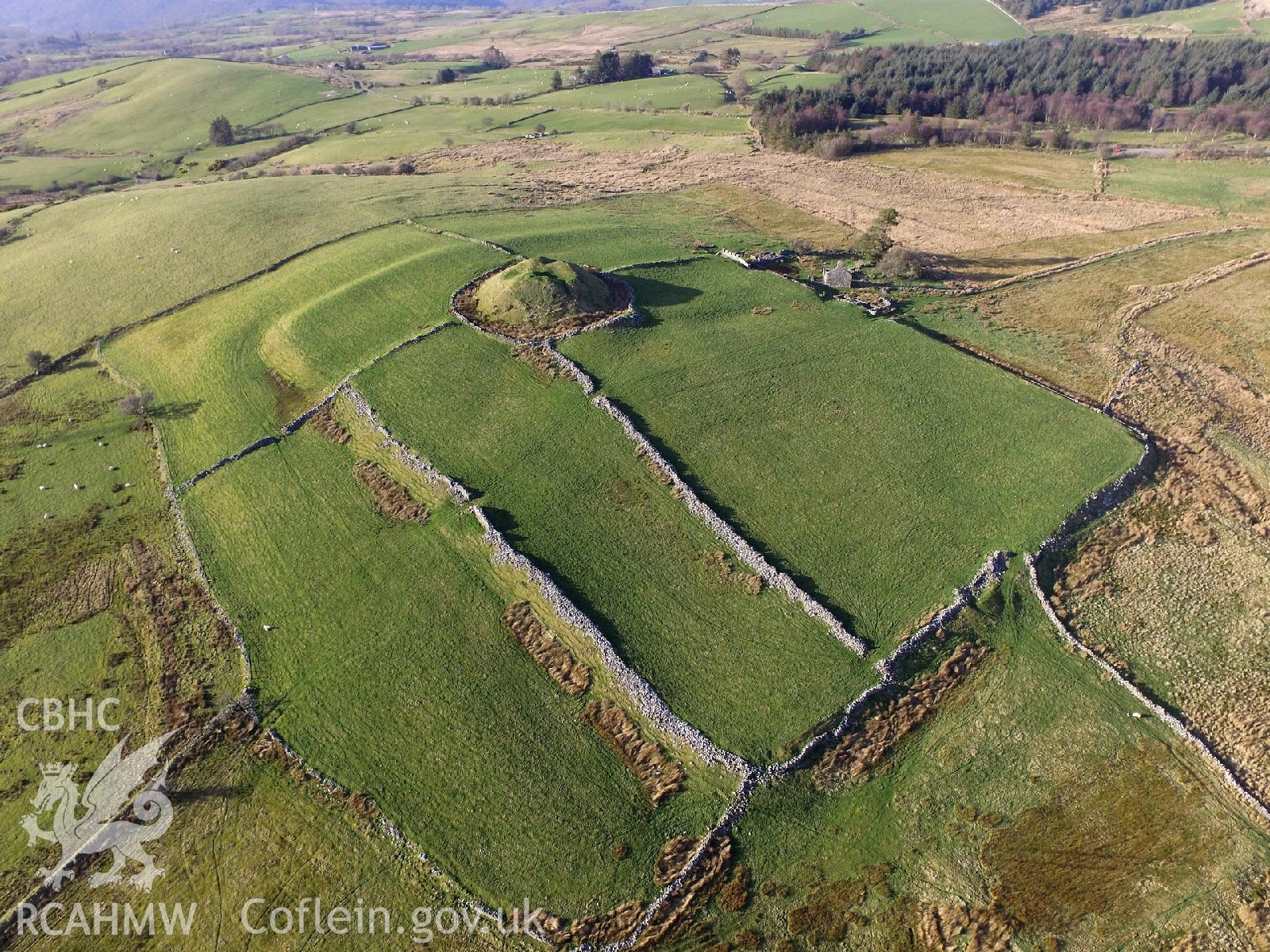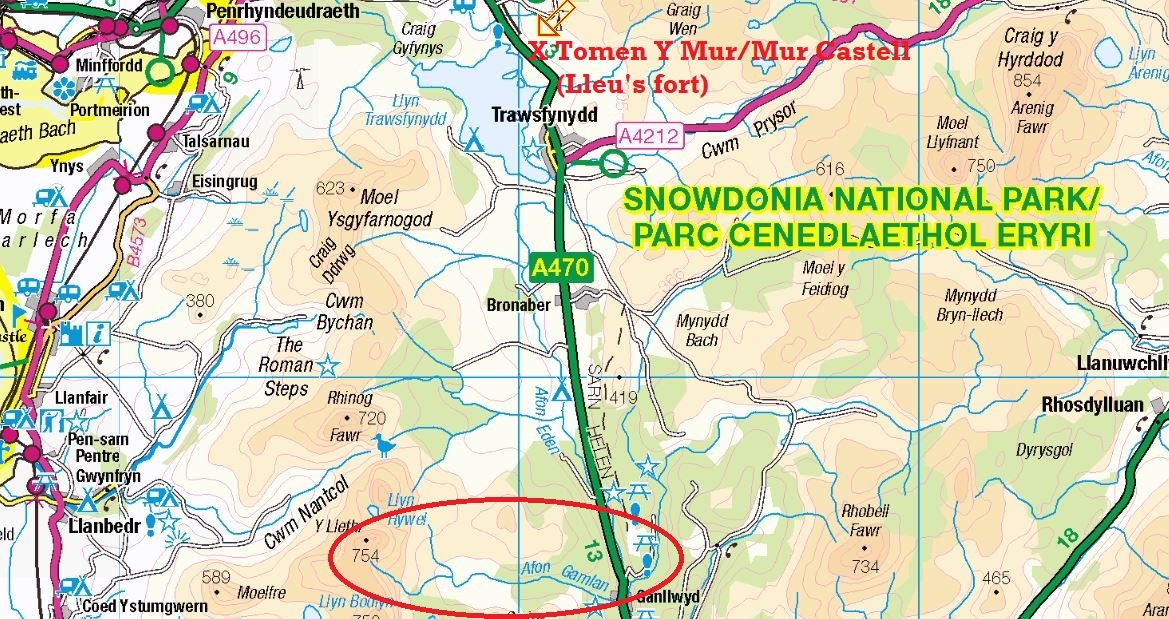Tomen Y Mur Roman Fort
For decades now, I've stubbornly clung to my derivation of the W. name Medraut from the Latin Moderatus. This proposed etymology had the stamp of approval from none other than Professor Oliver J. Padel.
I've only recently come to realize that I'm only partially right.
Yes, Geoffrey of Monmouth's Modred, picked up from extreme southern Cornwall, does indeed appear to be from Moderatus. Although place-name scholars insist on a very similar name preserved at Moddershall in Staffordshire as being of English origin.
The Welsh, however, insist on giving precedence to their own form of the name. They are not happy about the Cornish scholar Padel's suggestion that Modr- was simply related by the Welsh to their word medr.
Instead, as Dr. Simon Rodway prefers, Medraut is, rsther transparently, from W. Medr plus the suffix -awd. The meaning of the name, in his opinion, means "Skilful vel sim."
Here is medr and medrus from the GPC:
medr1
[?cf. Gal. mataris ‘gwaywffon’, Gr. μέτρον ‘mesur’]
eg. ll. (diw.) medrau.
a Deheurwydd sy’n deillio o hyfforddiant neu o brofiad, sgìl, hyfedredd mewn crefft neu gelfyddyd neilltuol, medrusrwydd, gallu:
skill, proficiency, ability, capacity.
medrus
[medr1+-us]
a. ll. medrusion.
Celfydd, cywrain, deheuig, hyfedr, galluog, clyfar; moesgar, cwrtais, boneddigaidd, da ei foes, llednais, gweddaidd, ffurfiol, cywir:
skilful, dexterous, deft, adroit, able, clever; well-mannered, courteous, polite, well-behaved, decorous, formal, correct.
Hence, Medraut is "the Skilful One" or similar.
Such a meaning got me to thinking about the Welsh god Lleu Llaw Gyffes.
Gyffes or cyffes is defined as follows in the GPC:
cyffes2
[?cyffes < *cyf-hes < Clt. *kobo-sed-to-, sef cyfansoddair o’r gwr. *kob- ‘llwyddo’ (a welir yn yr e. prs. Gal. Vercobius a’r H. Wydd. cob ‘buggugoliaeth’) a ff. ar y gwr. *sed- ‘eistedd, aros’]
a.
Parod, celfydd, medrus, deheuig, cywrain, cyfarwydd:
ready, skilful, adroit, dexterous, proficient, conversant.
I also recalled a number of other curious facts about Lleu. When Gwydion in MATH SON OF MATHONWY tricks Arianrhod into giving the boy a name, she proclaims -
Ys llaw gyfes y medrwys y Lleu ef lit. 'It is a skilful hand (llaw gyffes) by which the fair one (lleu) strikes (medrwys).'
Medrwys is from the same medr:
medraf: medru
[bf. o’r e. medr1]
to hit, strike, shoots
We also find this listing in the GPC:
llawgyffes
[llaw1+cyffes2]
a.
Medrus ei law, deheuig:
deft(-handed), dextrous, adroit.
Submit
14g. WM 9714-15, ys llaw gyffes y medrwys y lleu ef.
Digwydd fel epithet yn yr e. prs. Lleu Llawgyffes.
The Irish cognate to Lleu is Lugh. He was a god of every skill. Two if his epithets, with definitions culled from the eDIL:
Samildánach
Samildánach as n. pr.: oglaech . . . Samhildánach a ainm-side, RC xii 74 § 53 `skilled in many arts together',
ildánach very gifted, skilled, accomplished, having many gifts or accomplishments (frequently used as subst.)
The Afon Gamlan, which the Welsh identify with Arthur's Camlan, is actually quite close to where the god Lleu had his chief fort and where he died.
In addition, the ancient hero Pryderi of Dyfed, in a battle with Gwydion of Gwynedd, perished in the same area.
I was looking at the Roman road that ran south from Lleu's Tomen Y Mur fort and noticed that it either crossed the Afon Gamlan or ran past the mouth of that river on the other side of the Afon Mawddach.
Before my readers try to anticipate what I'm going to conclude from this, let me quickly say that I'm not suggesting that Medraut the Skilful One should be identified with Lleu. Rather, I'm suggesting that the battle of Arthur and Medraut at the Afon Gamlan should be seen as a heroic parallel of the mythological Pryderi-Gwydion conflict.
Medraut would, in this case, be a sort of human avatar of Lleu, a chieftain who hailed from Tomen Y Mur or vicinity. He may have had an affinity with Lleu. Arthur is the son of Pedr of Dyfed, anachronistically placed in death at a time that accorded with his supposed victory at GIldas' Badon.
By doing this, the Welsh storytellers succeeded in using the tale of Pryderi and Lleu's foster-father Gwydion as a foreshadowing of the death of Arthur in the same way Old Testament events were utilized as prefiguiring Christ's deeds.
As I have discussed before -
- Medraut was given a Lleu (Loth of Lothian from the eponym for the "fort of Lleu" and Llew, doubtless a mispelling if Lleu) as a father in Geoffrey of Monmouth and in the Welsh version of the Galfridian "history." This is significant in the current context. In Welsh tradition, Lleu ruled Gwynedd. In addition to his chief fortress of Tomen Y Mur, he is associated with Dinas Dinlleu in Arfon.
I would be neglectful if I failed to mention in passing that Gwydion was fighting for Math, a name almost certainly drawn from the Irish word for bear. The Welsh saw in the name Arthur their own arth, 'bear.' Finally, the Afon Gamlan is in Ardudwy Is Artro or Ardudwy 'under [the Afon] Arthro'. While the derivation of Arthro is disputed, it may have been associated with the Arthur name.
One of the Dyffryn Ardudwy chambered tombs is named Arthur's Quoit. There is a strand of medieval tradition that identifies this pkace with Arthur's Avalon (see the second half of this blog: https://mistshadows.blogspot.com/2016/08/the-grave-of-king-arthur.html?m=1).
According to CULHWCH AND OLWEN, Uther had kin at Math's fortress of Caer Dathal in Arfon (= Dinas Emrys) and another Welsh source claims Arthur took a wife from there.
So, was there really a Medraut or should he be seen merely as a conjured character?
Well, there was a long tradition of warfare between Dyfed and Gwynedd. Part of that is enshrined in the MATH SON OF MATHONWY tale. But in the historical period we know that Dyfed took all of Ceredigion from Gwynedd, making it part of the new kingdom of
Seisyllwg.
I feel pretty confident that at least the Arthur of Camlan is Arthur of Dyfed. That is not to say he was properly associated with Badon. Nor do the HISTORIA BRITTONUM battles belong to him.
What we find in the HB is an anachronistically placed series of battles (or at least sites) that belong to L. Artorius Castus. It was this hero who gave his name to the royal sons of Irish-descended dynasties in Britain.
I would call attention to an excellent article written some time ago by Dr. Ken Dark. In this piece, the author explored what could be learned about the famous Arthur by looking at the later Irish examples.
Dark's conclusion regarding Castus is apt, given that he was going by information I now believe to be false:
"The alternative derivation of !he name from the Roman family
name 'Artorius' has serious problems. 'Artorius' is not an attested
Romano-British name, a1!hough it was, as is well-known, !hat of an
early Roman officer in Britain, Artorius Castus. Artorius Castus
definitely served in Britain, but most of his career was spent elsewhere
and he was not a high ranking officer when stationed at York. Nor is
he known to have done any!hing exceptional which is likely to have
made him revered by Britons as a hero. His only notable act in the
later 'Celtic' world was perhaps, and even !his is uncertain, to
command Roman forces in Armorica in 198. However, he was dead
and buried by about 200, and no trace of !he name' Artorius' is found
bereafter in Britain (althougb there were plenty of Artorii in the
Balk~s and Italy) until Arthur son of Pedr/Retheoir in the 570s.22
Consequently, despite the recent explication of bis career by Linda
Malcor, we may doubt whether he can be the basis of the later
Arthurian legend. This would require some memory of him being
preserved for almost 400 years before we have any trace of it and, as
already mentioned, there is no reason why he should have been any
more notable than any other middle-ranking Roman officer. But
without Artorius Castus there no Artorii known from Roman Britain
at all."
Note that Dark could have concluded the same thing had he opted for Armenia rather than Armorica.
As for Castus' rank, I would dispute the claim it was low. As an equestrian, his status as prefect of a legion represented the highest rank he would in ordinary circumstances be able to achieve.
If we then allow for Castus having taken three British legions north against armed tribes under Severus, the other part of Dark's negative argument also collapses.







No comments:
Post a Comment
Note: Only a member of this blog may post a comment.